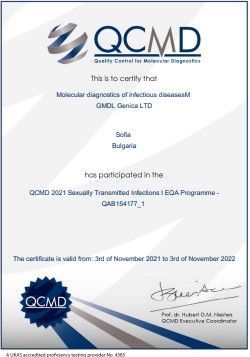Femoflor ®
Femoflor ® is a modern PCR-based test and the only diagnostic method that allows complex evaluation of vaginal microbiome composition, diagnosis of dysbiosis and detection of sexually transmitted infections. It is a first that with just one test is possible to determine the microbial vaginal composition in relation to all microorganisms inhabiting the female vaginal tract. Femoflor ® is the only test showing the full picture of the vaginal bacterial composition, distinguishing the norm from the disease. Bacterial vaginosis (BV) is a condition where certain bacteria predominate in the vagina. BV is associated with an imbalance of „good“ and „harmful“ bacteria, usually found in a woman's vagina. Bacterial vaginosis is the most common vaginal condition in women aged 15-44 years. Bacterial vaginosis is very often asymptomatic and can increase the risk of contracting sexually transmitted infections, as well as compromising intimate and reproductive health. Pregnant women are at increased risk of developing BV. Bacterial vaginosis during pregnancy is associated with a risk of miscarriage, premature birth, low birth weight and infection of the newborn. Treatment is especially important for pregnant women.
Diagnostic range: Lactobacillus spp., Enterobacterium spp., Streptococcus spp., Staphylococcus spp., Gardnerella vaginalis, Prevotella bivia, Porphyromonas spp, Eubacterium spp, Sneathia spp., Leptotrichia spp., Megasphaera spp., Veillonella spp., Dialister spp., Lachnobacterium spp., Mobiluncus spp., Corynebacterium spp., Clostridium spp., Peptostreptococcus spp., Atopobium vaginae, Ureaplasma urealyticum, Ureaplasma parvum, Mycoplasma hominis, Candida spp. , Mycoplasma genitalium, Fusobacterium spp
Diagnostic Method: Real-time PCR assay
Research Material: Vaginal swab
Results within: 1 business day
Fee: BGN 125
Clinical application
Diseases associated with bacterial vaginosis
Download Our Brochure
Femoflor Plus®
Femoflor plus® is a modern PCR-based test and the only diagnostic method that allows complex evaluation of vaginal microbiome composition, diagnosis of dysbiosis and detection of sexually transmitted infections. It is a first that with just one test is possible to determine the microbial vaginal composition in relation to all microorganisms inhabiting the female vaginal tract. Femoflor ® is the only test showing the full picture of the vaginal bacterial composition, distinguishing the norm from the disease.
Diagnostic Range: Lactobacillus spp., Enterobacterium spp., Streptococcus spp., Staphylococcus spp., Gardnerella vaginalis, Prevotella bivia, Porphyromonas spp, Eubacterium spp, Sneathia spp., Leptotrichia spp., Megasphaera spp., Veillonella spp., Dialister spp., Lachnobacterium spp., Mobiluncus spp., Corynebacterium spp., Clostridium spp., Peptostreptococcus spp., Atopobium vaginae, Ureaplasma urealyticum, Ureaplasma parvum, Mycoplasma hominis, Candida spp. , Mycoplasma genitalium, Fusobacterium spp, Chlamydia trachomatis, Trichomonas vaginalis, Neisseria gonorrhoeae
Diagnostic Method: Real-time PCR assay
Research Material: Vaginal and cervical specimen
Results within: 1 business day
Fee: BGN 187
Diseases associated with the range of Femoflor plus®
Vaginitis; Cervicitis; Predisposition to sexually transmitted infections; Pelvic inflammatory disease; Infertility; Spontaneous abortions; Premature birth; Neonatal infection
Download Our Brochure
Download Our Brochure
HPV
HPV is the most common sexually transmitted infection (STI). You can get HPV by having vaginal, anal, or oral sex with someone who has the virus. It is most commonly spread during vaginal or anal sex. HPV can be passed even when an infected person has no signs or symptoms.
There are many different types of HPV. Some types can cause health problems including genital warts and cancers. HPV can cause cervical and other cancers including cancer of the vulva, vagina, penis, or anus. It can also cause cancer in the back of the throat.
The only method for diagnosing HPV is to perform PCR assay, where DNA fragments of the virus are isolated and amplified. The HPV 16/18 test has extremely high specificity and sensitivity. It is the earliest prognostic marker for cervical cancer (the second most common cancer after breast cancer among women). See all our HPV tests here.
Diagnostic Range: 12 to 33 HPV types
Diagnostic Method: PCR Assay
Research Material: Cervical specimen
Results within: 1-5 business days
Fee: From BGN 66 to BGN 167
Diseases associated with HPV
Cervical dysplasia; Cervical cancer; Oral cancer; Cancer of the vulva and vagina; Penile cancer; Anal cancer; Genital warts
Download Our Brochure
Download Our Brochure
Androflor®
Androflor® is the only complex test for determining the clinically significant concentration of all microorganisms inhabiting the male urogenital tract. Infections in the male urogenital tract are a global problem and are gaining ever more social and economic significance.
Urogenital infections are the most common cause of reproductive dysfunction in men and a major factor in infertility development. Acute and chronic infections damage the germinal epithelium of the testicles, disrupt spermatogenesis, and impair the quality of semen. The lack of symptoms is the reason infections go unnoticed and transmitted to the sexual partner.
Diagnostic Range: ACE
Diagnostic Method: Real-time PCR assay
Research Material: Urine / Ejaculate
Results within: 1 business day
Fee: BGN 197
Diseases associated with the range of Androflor®
Urethritis; Enlarged prostate; Acute prostatitis; Chronic prostatitis; Orchitis and epididymitis; Balanitis; Inflammation of the seminal ducts; Inflammation of the spermatic cord, tunica vaginalis and vas deferens; Secondary infertility
Download Our Brochure
FERTILITY TEST®
The FERTILITY TEST® allows for the detection of direct bacterial and viral activity, associated with the development of infections causing infertility.
The FERTILITY TEST® allows the diagnosis of genital viral and bacterial infections inhabiting the endometrium without the need for invasive interventions. The integration of FERTILITY TEST® is recommended in routine gynecological screening tests to ensure comprehensive diagnosis and treatment of the infection before serious side effects from undetected infections occur. The FERTILITY TEST® is the right choice in the diagnosis of endometritis and pelvic inflammatory disease (PID), oligospermia, asthenospermia and teratospermia, unclear sterility.
Diagnostic Range: Herpes family HHV-1 to -8 (HSV-1, HSV-2, CMV, EBV, VZV, HHV-6, HHV-7, HHV-8) and Chlamydia trachomatis, Ureaplasma urealyticum, Ureaplasma parvum, Mycoplasma hominis, Mycoplasma genitalium, Neisseria gonorrhoeae, Trichomonas vaginalis, Gardnerella vaginalis
Diagnostic Method: PCR Assay
Research Material: Menstrual tissue / Ejaculate
Results within: 5 business days
Fee: BGN 250
Clinical application
Gynecological prophylaxis, endometritis, pelvic inflammatory disease (PID), oligospermia, asthenospermia and teratospermia, unclear sterility
Download Our Brochure
Chlamydia
Chlamydia is a common STD that can infect both men and women. It can cause serious, permanent damage to a woman's reproductive system. This can make it difficult or impossible for her to get pregnant later on. Currently, PCR assay is the gold standard for the diagnosis of chlamydial infections (See the diagnostic recommendations of the Centers for Disease Control and Prevention HERE).
Diagnostic Range: Chlamydia trachomatis
Diagnostic Method: PCR Assay
Research Material: Cervical sample / Endometrial menstrual tissue / Urine / Ejaculate /
Results within: 1 business day
Fee: BGN 35
Diseases associated with chlamydial infection
Cervicitis; Urethritis; Epididymitis; Prostatitis; Premature birth; Pelvic inflammatory disease; Ectopic pregnancy, Infertility; Spontaneous abortions; Newborn infections
Download Our Certificate
Gonorrhea
Gonorrhea is a sexually transmitted disease (STD) caused by infection with the Neisseria gonorrhoeae bacterium. It can infect both men and women and is transmitted through vaginal, anal and oral sexual contact with an infected partner.
Gonorrhea is a very common infectious disease especially among young people aged 15-24. It can affect the genitals, rectum, and throat, depending on sexual practices.
Untreated gonorrhea can cause serious and permanent health problems in both women and men. The infection can also be spread perinatally from mother to baby during childbirth.
Currently, PCR analysis is the gold standard for the diagnosis of gonococcal infections (See the diagnostic recommendations of the Centers for Disease Control and Prevention HERE).
Diagnostic Range: Neisseria gonorrhoeae
Diagnostic Method: PCR Assay
Research Material: Cervical sample / Endometrial menstrual tissue / Urine / Ejaculate /
Results within: 1 business day
Fee: BGN 35
Diseases associated with gonorrhea
Cervicitis; Urethritis; Epididymitis; Prostatitis; Premature birth; Pelvic inflammatory disease; Ectopic pregnancy, Infertility; Spontaneous abortions; Newborn infections
Download Our Certificate
Herpes Simplex Virus
Genital herpes is a sexually transmitted disease caused by two types of viruses - herpes simplex virus type 1 (HSV-1) and herpes simplex virus type 2 (HSV-2). Genital herpes is usually caused by HSV-2, but oral herpes caused by HSV-1 can be transmitted from the mouth to the genitals through oral sex. Therefore, some cases of genital herpes are caused by HSV-1.
Most people with the virus don’t have symptoms. Even without signs of the disease, herpes can still be spread to sex partners. One in six people between the ages of 14 and 49 has genital herpes.
It is very important for pregnant women with genital herpes to have adequate prenatal care.
Herpes infection can be passed from the mother to her unborn child before birth but is more commonly passed to the infant during delivery. This can lead to a potentially deadly infection in the newborn (called neonatal herpes).
If herpes infection is suspected, PCR analysis is performed on a sore (vesicular) sample.
Diagnostic Range: HSV-1; HSV-2
Diagnostic Method: PCR Assay
Research Material: Vesicular sample / Vaginal sample / Cervical sample / Ejaculate
Results within: 1-5 business days
Fee: BGN 45
Diseases associated with herpes virus infection
Genital herpes; Spontaneous abortions; Neonatal Herpes; Meningitis; Proctitis
Download Our Certificate
Genital Mycoplasmas
In man, genital mycoplasmas are responsible for approximately 15%–20% of nongonococcal urethritis (NGU) cases, 20%–25% of nonchlamydial NGU, and approximately 30% of persistent or recurrent urethritis.
In women, genital mycoplasmas are associated with the development of bacterial vaginosis and can be detected in 10%–30% of women with clinical cervicitis. Genital mycoplasmas have been detected in up to 22% of Pelvic inflammatory disease (PID) cases which demonstrates the involvement of these bacteria in the development of reproductive problems - infertility, miscarriages, premature birth, infection of the newborn.
Genital mycoplasmas are highly unstable in an external environment. The microbiological culture Fails to detect 40-50% of gynecological samples. For Mycoplasma genitalium culture can take up to 6 weeks and only a few laboratories in the world are able to restore clinical isolates. Therefore, PCR is the preferred method for detecting genital mycoplasmas.
Diagnostic Range: Mycoplasma hominis/ Mycoplasma genitalium/ Ureaplasma urealiticum/ Ureaplasma parvum
Diagnostic Method: PCR Assay
Research Material: Cervical specimen / Urine / Ejaculate / Endometrial menstrual tissue
Results within: 1 business day
Fee: BGN 54
Diseases associated with genital mycoplasmas
Vaginitis; Cervicitis; Urethritis; Epididymitis; Prostatitis; Premature birth; Pelvic inflammatory disease; Ectopic pregnancy, Infertility; Spontaneous abortions; Newborn infections
Download Our Brochure
Trichomoniasis
Trichomoniasis is a very common sexually transmitted disease (STD). It is caused by infection with a protozoan parasite called Trichomonas vaginalis. Although symptoms of the disease vary, most people who have the parasite cannot tell they are infected. only about 30% develop any symptoms of trichomoniasis.
The parasite passes from an infected person to an uninfected person during sex. In women, the most commonly infected part of the body is the lower genital tract (vulva, vagina, cervix, or urethra). In men, the most commonly infected body part is the inside of the penis (urethra).
Pregnant women with trichomoniasis are more likely to have their babies too early (preterm delivery).
It is not possible to diagnose trichomoniasis based on symptoms alone. For both men and women, the care provider should prescribe a laboratory test to diagnose trichomoniasis.
Diagnostic Range: Trichomonas vaginalis
Diagnostic Method: PCR Assay
Research Material: Vaginal specimen / Cervical specimen / Urine / Ejaculate /
Results within: 1 business day
Fee: BGN 35
Diseases associated with Trichomonas vaginalis
Cervicitis; Vaginitis; Urethritis; Epididymitis; Prostatitis; Premature birth
Download Our Certificate
Hepatitis C
Hepatitis C is a liver infection caused by the hepatitis C virus (HCV). Hepatitis C is spread through contact with blood from an infected person. Most people become infected with the hepatitis C virus by sharing needles or other equipment used to prepare and inject drugs.
HCV is not effectively transmitted sexually, but data show that it can occur, especially among people with HIV infection.
For some people, hepatitis C is a short-term illness, but for more than half of people who become infected with the hepatitis C virus, it becomes a long-term, chronic infection. Chronic hepatitis C can result in serious, even life-threatening health problems like cirrhosis and liver cancer. People with chronic hepatitis C can often have no symptoms and don’t feel sick. When symptoms appear, they often are a sign of advanced liver disease.
There is no vaccine for hepatitis C. The best way to prevent hepatitis C is by avoiding behaviors that can spread the disease, especially injecting drugs.
Getting tested for hepatitis C is important, because treatments can cure most people with hepatitis C in 8 to 12 weeks.
Centers for Disease Control and Prevention recommends one-time hepatitis C testing of all adults (18 years and older) and all pregnant women during every pregnancy. CDC continues to recommend people with risk factors, including people who inject drugs, be tested regularly.
Diagnostic Range: Hepatitis C
Diagnostic Method: PCR Assay
Research Material: 3 ml venous blood
Results within: 1-5 business days
Fee: BGN 150
Diseases associated with hepatitis C.
Hepatitis; Cirrhosis; Liver cancer
Syphilis
Syphilis is a sexually transmitted diseases (STD) that can have very serious complications when left untreated. One can get syphilis through vaginal, anal, or oral sex. An initial symptom of syphilis is the presence of vesicles (sores) on or around the penis, vagina, or anus, or in the rectum, on the lips, or in the mouth. Syphilis can spread from an infected mother to her unborn baby. To protect their baby, future mothers should be tested for syphilis at least once during their pregnancy.
Diagnostic Range: Treponema palllidum
Diagnostic Method: PCR Assay
Research Material: Vesicular sample / Venous blood / Biopsy tissue
Results within: 1-5 business days
Fee: BGN 45
Diseases associated with Treponema Pallidum infection
Syphilis; Spontaneous abortion; Premature birth; Stillbirth; Neonatal infection; Ocular syphilis; Neurosyphilis
Download Our Certificate
Hepatitis B
Hepatitis B is a liver infection caused by the hepatitis B virus (HBV). Hepatitis B is spread when blood, semen, or other body fluids from a person infected with the virus enters the body of someone who is not infected. This can happen through sexual contact; sharing needles, syringes, or other drug-injection equipment; or from mother to baby at birth. Not all people newly infected with HBV have symptoms.
For many people, hepatitis B is a short-term illness. For others, it can become a long-term, chronic infection that can lead to serious, even life-threatening health issues like cirrhosis or liver cancer. The best way to prevent hepatitis B is to get vaccinated.
Diagnostic Range: Hepatit B virus
Diagnostic Method: PCR Assay
Research Material: 3 ml venous blood
Results within: 1-5 business days
Fee: BGN 75
Diseases associated with Hepatitis B
Hepatitis; Cirrhosis; Liver cancer








